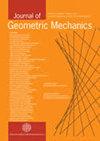Nonlinear dispersion in wave-current interactions
IF 1
4区 数学
Q3 MATHEMATICS, APPLIED
引用次数: 2
Abstract
Via a sequence of approximations of the Lagrangian in Hamilton's principle for dispersive nonlinear gravity waves we derive a hierarchy of Hamiltonian models for describing wave-current interaction (WCI) in nonlinear dispersive wave dynamics on free surfaces. A subclass of these WCI Hamiltonians admits emergent singular solutions for certain initial conditions. These singular solutions are identified with a singular momentum map for left action of the diffeomorphisms on a semidirect-product Lie algebra. This semidirect-product Lie algebra comprises vector fields representing horizontal current velocity acting on scalar functions representing wave elevation. We use computational simulations to demonstrate the dynamical interactions of the emergent wavefront trains which are admitted by this special subclass of Hamiltonians for a variety of initial conditions.In this paper, we investigate:(1) A variety of localised initial current configurations in still water whose subsequent propagation generates surface-elevation dynamics on an initially flat surface; and(2) The release of initially confined configurations of surface elevation in still water that generate dynamically interacting fronts of localised currents and wave trains. The results of these simulations show intricate wave-current interaction patterns whose structures are similar to those seen, for example, in Synthetic Aperture Radar (SAR) images taken from the space shuttle.波流相互作用中的非线性色散
通过对色散非线性重力波的哈密顿原理中的拉格朗日量的一系列近似,我们导出了描述自由表面上非线性色散波动力学中的波流相互作用(WCI)的哈密顿模型层次。这些WCI哈密顿量的一个子类在某些初始条件下允许出现奇异解。用半直积李代数上微分同态左作用的奇异动量映射来标识这些奇异解。这种半直积李代数包括表示水平流速作用于表示波浪高程的标量函数的向量场。我们用计算模拟证明了在各种初始条件下这一特殊哈密顿子类所允许的突现波前列的动力学相互作用。本文研究:(1)静水中各种局部初始水流构型,其后续传播在初始平坦表面上产生表面高程动力学;(2)静水中表面高程初始受限构型的释放,产生局域流和波列的动态相互作用锋面。这些模拟的结果显示了复杂的波流相互作用模式,其结构与从航天飞机上拍摄的合成孔径雷达(SAR)图像所看到的相似。
本文章由计算机程序翻译,如有差异,请以英文原文为准。
求助全文
约1分钟内获得全文
求助全文
来源期刊

Journal of Geometric Mechanics
MATHEMATICS, APPLIED-PHYSICS, MATHEMATICAL
CiteScore
1.70
自引率
12.50%
发文量
23
审稿时长
>12 weeks
期刊介绍:
The Journal of Geometric Mechanics (JGM) aims to publish research articles devoted to geometric methods (in a broad sense) in mechanics and control theory, and intends to facilitate interaction between theory and applications. Advances in the following topics are welcomed by the journal:
1. Lagrangian and Hamiltonian mechanics
2. Symplectic and Poisson geometry and their applications to mechanics
3. Geometric and optimal control theory
4. Geometric and variational integration
5. Geometry of stochastic systems
6. Geometric methods in dynamical systems
7. Continuum mechanics
8. Classical field theory
9. Fluid mechanics
10. Infinite-dimensional dynamical systems
11. Quantum mechanics and quantum information theory
12. Applications in physics, technology, engineering and the biological sciences.
 求助内容:
求助内容: 应助结果提醒方式:
应助结果提醒方式:


